Review: OBROG OWOK-OWOK EBREG EWEK-EWEK is a Fascinating and Bewildering Look into the Past
The musical adaptation ran for 4 shows on February 11 and 12.
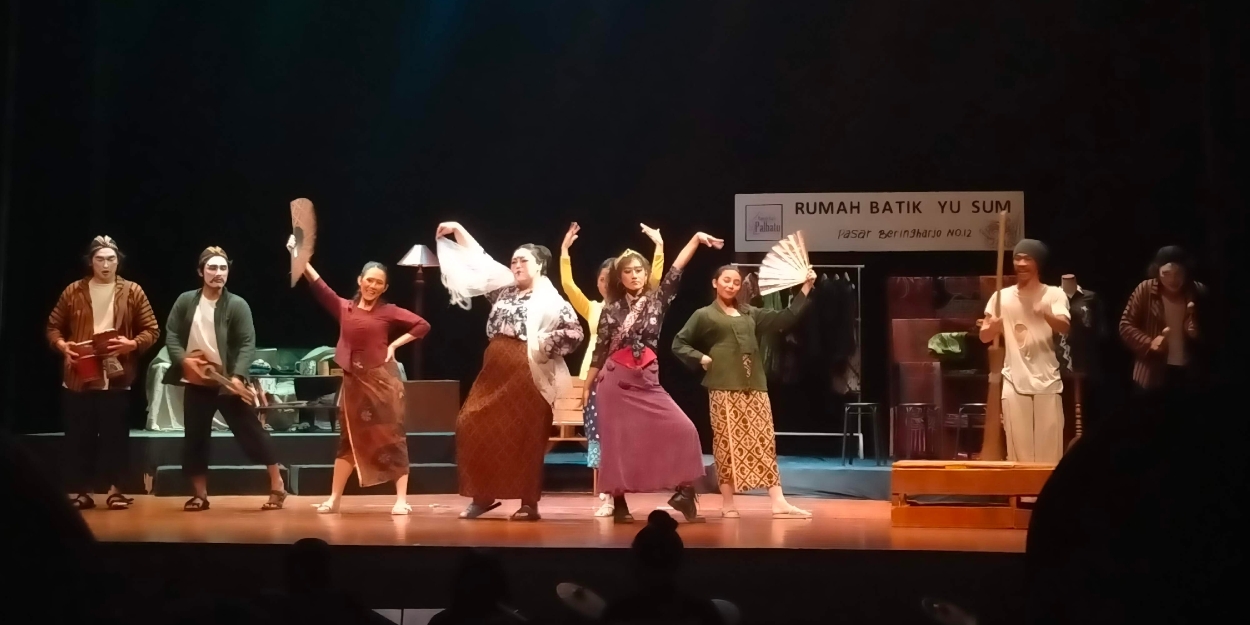
On February 11 and 12, the literature community Lentera Kata held their second theatrical performance: Obrog Owok-Owok Ebreg Ewek-Ewek (OOOEEE) at Teater Kecil. OOOEEE is a play by Indonesian writer Danarto written in 1973. This production is directed by M. Yoesoev and features original pieces of music, directed by Ahmad Ilyas as the music director.
OOOEEE takes place in Yogyakarta in the 1970s. Tommy (Idham Aulia Shaffansyah) is a college student majoring in fine arts. He’s in a romantic, or at least flirtatious, relationship with Sumirah (Nupiti), a batik merchant who owns and runs a stall at the famous Beringharjo market, assisted by her workers (Lumongga Harahap and Yasmine Athira).
Yet he’s actually two-timing her with Kusningtyas (Nadira Dayo), the daughter of Professor (M. Rizqy Ramadiyo), the supervising professor for Tommy’s graduation project. Tommy dates both Sumirah and Kusningtyah in hopes of financial gains and academic perks, respectively. To further secure his graduation, the cunning Tommy also tries to make nice with the professor and his wife (Imana Tahira).
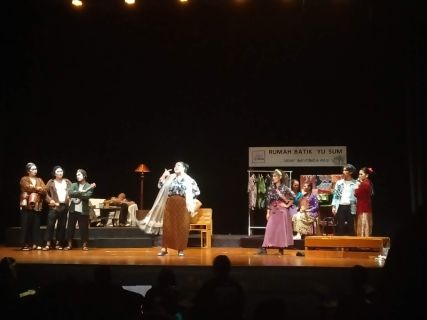
Watching and providing color commentary on this love triangle is Slentem (Rizky Septian), a janitor at the market. He also serves as the cheeky narrator of the story, often making fourth-wall breaking asides toward the audience.
The drama regarding Tommy’s graduation and love triangle unfolds alongside a B-plot: the traditional street busker Sariyem (Ribka Euodia Sumampow) and her trio of musicians (Ochen Shaq, Fath Diposumanaji, and Sahbani Zein) are having a feud with another busker, Warti (Annindya Azmah). The traditionalists see Warti as a threat, as she sings using the latest in modern technology: a portable tape recorder.
A fight breaks out and Sariyem and Warti go off stage, both women aiming a bow at each other. Eventually, Slentem settles the conflict by enacting a treatise between the buskers, allowing traditional buskers to only perform traditional songs and buskers with tape recorders to only play international songs.
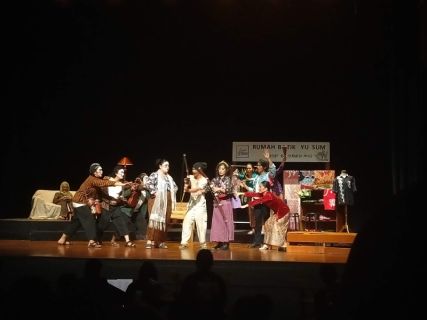
Slentem also hatches a plan to get the stern professor to graduate Tommy: sending him an anonymous letter. But seeing the professor not budging, he goes to confront him in a disguise before revealing his identity and demand. Not so easily intimidated, the professor challenges Slentem to a fist fight. But the ever-nimble Slentem evades him and goes off-stage. The professor and his wife chase him.
When Slentem comes back, we see that everyone has aged decades, with a headful of gray hair and wrinkles adorning their faces. That is, everyone – including the musicians and the shopkeepers – except for Slentem. He then monologues about how everyone else chooses to move forward while he leaps back in time to stay youthful. He narrates a bit of epilogue, claiming that the professor now has a herd of grandchildren and great-grandchildren from both Sumirah and Kusningtyas, while the buskers can do their business in peace after the treatise. The play ends with the cast singing the play’s title – a string of words not meaning anything in particular.
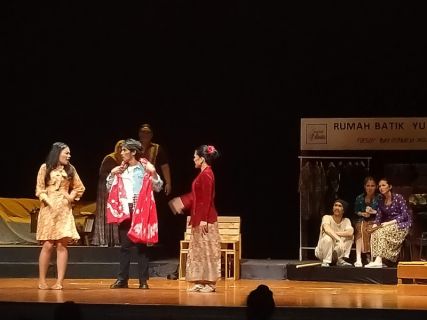
As a 50-year old script, there is a lot in OOOEEE’s script that might seem incomprehensible to modern audiences. But there’s a lot of theatrical creativity as well. The most apparent is the usage of the same line of dialogue being said by two characters (or more) at the same time, either in similar or wildly different contexts. For example, both the Professor and Slentem scoff at Tommy’s work; but they are in two different situations, with the Professor being at home with his wife, and Slentem at the market with the shopkeepers.
Another juxtaposed portrayal of different physical spaces comes in a subplot where Slentem gives a magic hair that enables Sumirah to somehow swipe a chalk from the Professor’s hand, despite Sumirah being miles away from the Professor’s hand. On stage, this is accomplished by Sumirah yanking said object from the Professor’s side of the stage, which stands for his house.
There are also fascinating moments where the main plot (i.e. Tommy and the Professor) and the B-plot (the buskers) spill over into each other, such as when a conversation between Sumirah and the Professor is interrupted by Sariyem and Warti chasing each other.
Danarto’s script explores the bounds of theater and breaks conventional rules, which is doubly impressive considering its age. That being said, it doesn’t necessarily make for the most pleasant theatrical experience. It is intriguing at the expense of enjoyability at parts.

The same lines of dialogue being said simultaneously gets rather annoying due to its overuse and can make following all the lines a bit difficult. And the weirdly philosophical ending just ends, not really giving narrative closure to the main plot. We never know if Tommy gets his degree or not in the end.
OOOEEE is still a great snapshot to both the theatrical scene and the cultural zeitgeist of the 1970s captured by Danarto. There are interesting themes about the haughtiness of academia, conflict between old and new generations of buskers, the lack of royalty paid to artists, and many more.
The play is inherently mystical, bewildering, mystifying, yet deep inside it’s rooted in physical reality; it might not be for everyone, but it’s excellent at what it sets out to do. The director understands this well, going for a heightened reality take, instead of going fully fantastical or realistic.
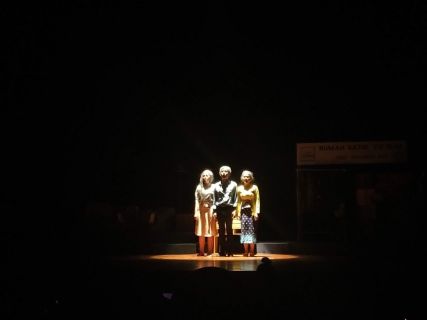
The production design also supports this direction. The outfit choices go for a realistic take, with Slentem’s tattered clothing especially making such a bold impression indicative of his role. The same goes for the lighting and set design, opting to help ground the dreamy script more rather than pushing towards the dramatic (except for the final scene).
The cast are also excellent at their work. Rizky Septian as Slentem is particularly impressive. His lithe physicality, impish personality, and deliciously off-beat dynamic with all the other characters make for a memorable performance. He and the other characters at the market also retain a delightfully consistent regional accent.
Some other stand-outs include Ribka Sumampow’s gorgeous singing voice, Annindya Azmah’s sassiness, and how M. Rizqy Ramadiyo’s Professor is so believably – and frustratingly – obtuse. Many of the other roles don’t get a lot of material to delve into, even Idham Aulia Shaffansyah’s slick Tommy himself (despite his batik project being the crux of the script), and Nadira Dayo’s coquettish ingenue Kusningtyas. But it does make us look forward to these budding actors to get a meatier role in the future to fully show off their acting skills.
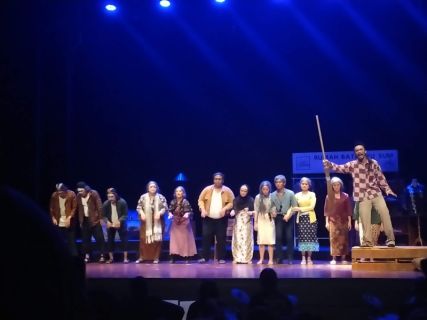
The music here is invented wholesale for the play. Some of them turn out great, such as the traditional buskers’ crowd-pleasing music, which made the Beringharjo busking scene that much more alive, while others are perhaps a bit awkwardly placed, since the original scenes were not written with a song in mind. Overall, they mostly make for welcome breaks from the script’s puzzling storyline.
Taken as a whole, Obrog Owok-Owok Ebreg Ewek-Ewek is an enduring theatrical piece that should be appreciated for its inventiveness, imagination, and social commentary. Although it might not be as easily digestible for audiences in 2024, there’s still a lot to enjoy from this production. As a relatively new community, Lentera Kata’s effort in bringing classic Indonesian scripts for the modern audience is truly admirable.
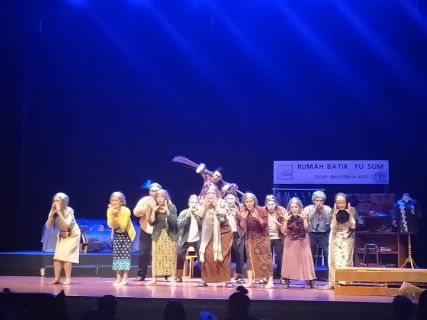
Reader Reviews

Videos

